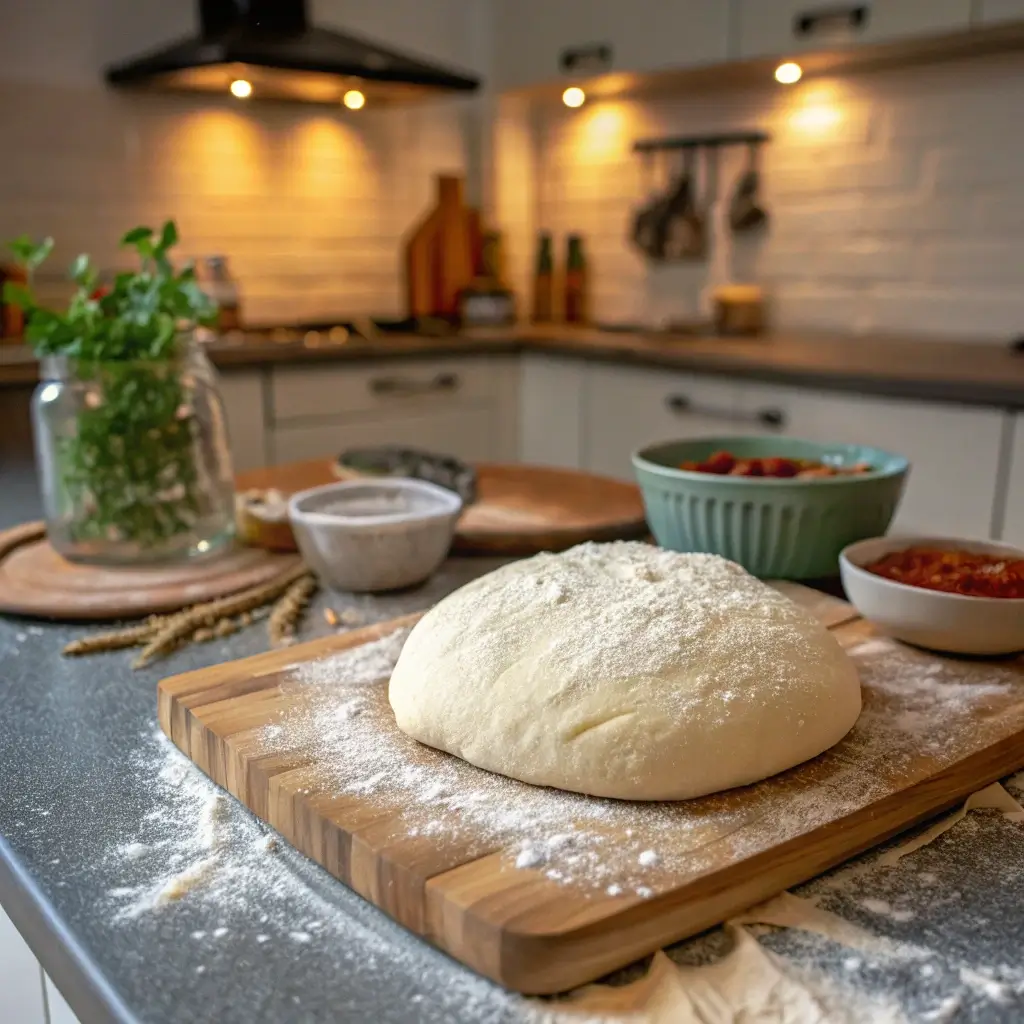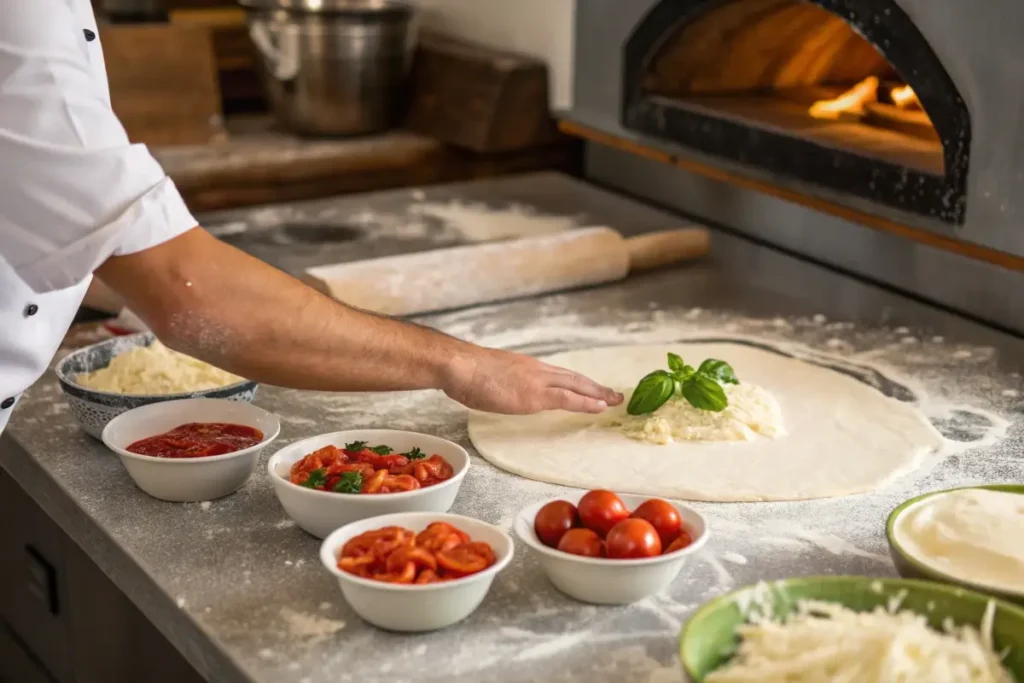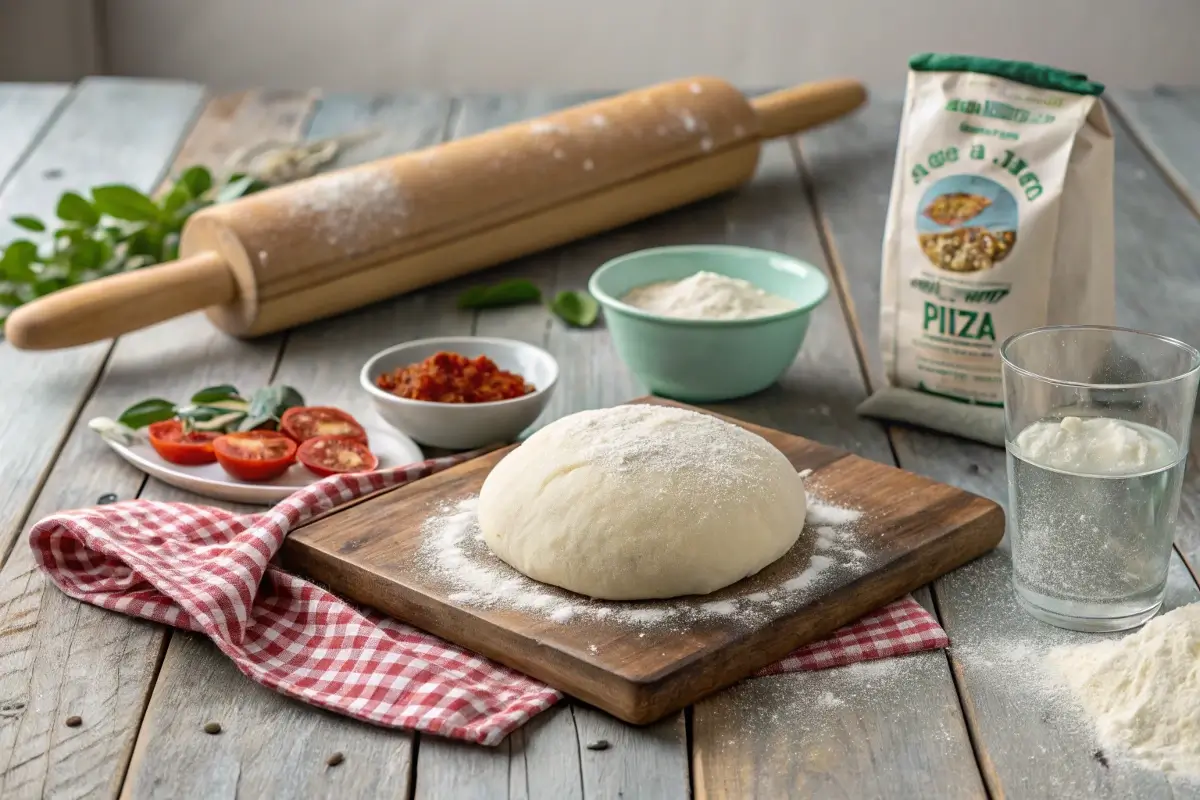A truly great pizza starts with perfect dough. While toppings and sauce play an important role, the dough is the foundation of any authentic Italian pizza. In Italy, pizza dough is simple, yet carefully crafted, using just a few high-quality ingredients to achieve a light, airy, and flavorful crust.
Unlike thick, doughy American-style pizza crusts, authentic Italian pizza dough is thin, crispy on the outside, yet soft and chewy on the inside. Whether you are making a classic Neapolitan pizza, a Roman-style thin-crust, or a Sicilian-style thick-crust, knowing how to make the perfect pizza dough will elevate your homemade pizza to restaurant quality.
In this guide, we’ll take you through the traditional ingredients, step-by-step dough preparation, fermentation techniques, baking tips, and expert tricks to help you master authentic Italian pizza dough at home.
Table of Contents
Why You’ll Love This Guide
Simple and Authentic
Authentic Italian pizza dough is made with only flour, water, yeast, salt, and olive oil—no unnecessary additives or complicated ingredients.
Easy to Make at Home
With the right techniques and fermentation process, you can achieve a professional-quality dough in your home kitchen.
Perfect Texture and Flavor
The proper fermentation allows for a light, airy, and slightly crispy crust, just like the pizzas found in Italy.
Versatile for Different Styles
This dough can be used for Neapolitan, Roman, Sicilian, and even focaccia-style pizzas, making it perfect for all your pizza cravings.

Essential Ingredients for Authentic Italian Pizza Dough
The secret to great Italian pizza dough lies in using high-quality ingredients and following the correct techniques.
Flour: The Foundation of the Dough
The type of flour you choose greatly impacts the texture and structure of your pizza dough.
- 00 Flour – The gold standard for Italian pizza dough, this finely milled flour creates a soft, elastic, and perfectly crispy crust.
- Bread Flour – Has a higher protein content, making the dough slightly chewier and more structured.
- All-Purpose Flour – Can be used in a pinch but lacks the strength of 00 or bread flour.
Water: Hydration for the Perfect Dough
Using filtered, room-temperature water is best. The right hydration level (around 60–65%) ensures the dough is soft, easy to stretch, and bakes with a perfect texture.
Yeast: The Rising Agent
- Fresh Yeast – Preferred in Italy for its natural fermentation and deep flavor.
- Active Dry Yeast – Must be dissolved in water before use but works well for home bakers.
- Instant Yeast – Can be mixed directly into the flour, making the process slightly easier.
Salt: Enhancing Flavor and Dough Structure
Sea salt is the best choice for pizza dough. It strengthens the gluten structure and enhances the natural flavors of the flour.
Olive Oil: Adds Elasticity and Flavor
Extra virgin olive oil is optional but helps create a slightly softer dough with added richness.
Types of Italian Pizza Dough
Neapolitan Pizza Dough
The most traditional pizza dough, made with 00 flour, water, yeast, and salt. It is fermented for at least 24 hours, creating a soft, light, and airy crust that puffs up beautifully when baked in a high-temperature oven.
Roman-Style Pizza Dough
This dough is thinner and crispier than Neapolitan pizza, often containing a higher hydration level (up to 70%) for extra crunch.
Sicilian Pizza Dough
A thicker, more bread-like dough, often baked in a pan with olive oil for a golden, crispy crust.
Focaccia Pizza Dough
A highly hydrated dough that produces a soft, airy texture, often topped with rosemary, sea salt, and olive oil.
Step-by-Step Guide to Making Authentic Italian Pizza Dough

Step One: Mixing the Ingredients
- In a large mixing bowl, combine 500g (4 cups) of 00 flour with 10g (2 teaspoons) of salt.
- In a separate small bowl, dissolve 3g (1 teaspoon) of yeast in 325ml (1⅓ cups) of lukewarm water and let it sit for 5 minutes.
- Slowly pour the yeast mixture into the flour, mixing with a spoon or your hands until it forms a rough dough.
- If using olive oil, add 1 tablespoon of extra virgin olive oil and mix until incorporated.
Step Two: Kneading the Dough
- Transfer the dough onto a floured surface and knead for 10–15 minutes until smooth and elastic.
- To check if the dough is ready, press a finger into it—if it springs back slowly, it has developed enough gluten.
Step Three: First Fermentation (Bulk Fermentation)
- Place the kneaded dough in a lightly oiled bowl and cover with a damp towel or plastic wrap.
- Let it rise at room temperature (around 20–22°C or 68–72°F) for at least 8 hours, or up to 24 hours for maximum flavor development.
Step Four: Shaping and Second Fermentation
- After the first rise, divide the dough into equal portions (for individual pizzas) and shape them into smooth balls.
- Let them rest for another 2–4 hours at room temperature, covered with a cloth.
Step Five: Stretching the Dough
- On a lightly floured surface, press down in the center of the dough ball, pushing outward to form a thin, round base while leaving a slightly thicker edge.
- Avoid using a rolling pin, as it will deflate the air pockets that create a light and airy crust.
Step Six: Baking the Pizza
- Preheat your oven to 250°C (480°F) or the highest setting possible.
- If using a pizza stone, preheat it for at least 30 minutes to ensure a crispy crust.
- Transfer the stretched dough onto a pizza peel or baking tray, add your sauce and toppings, and bake for 7–10 minutes, or until golden and bubbly.
- For a truly authentic Neapolitan pizza, bake in a wood-fired oven at 450–500°C (850°F) for just 60–90 seconds.
Tips and Tricks for Perfect Pizza Dough
- Longer fermentation = better flavor. Letting the dough rise slowly over 24 hours will produce a more complex and airy crust.
- Use minimal yeast to allow for a slow, natural fermentation.
- Keep the dough hydrated—a good hydration level ensures a soft, stretchy texture.
- Never roll out the dough—always stretch by hand to preserve air bubbles.
- Use a hot oven—high heat is essential for achieving a crispy, puffy crust.
Common Mistakes to Avoid
- Using too much yeast—this can make the dough over-ferment and taste overly yeasty.
- Not allowing enough fermentation time—rushing the process will result in a dense, flavorless crust.
- Overloading with toppings—too many toppings can make the dough soggy and prevent even cooking.
- Not preheating the oven properly—a cold oven won’t produce the crispy texture found in Italian pizzas.
FAQs
What is the best flour for pizza dough?
00 flour is the best choice for an authentic Italian crust, as it creates a soft, airy, and slightly crispy texture.
How long should I let my pizza dough rise?
For the best flavor, allow it to ferment for at least 8 hours, but ideally 24 hours.
Can I freeze pizza dough?
Yes, pizza dough can be stored in the freezer for up to 3 months. Let it thaw overnight in the refrigerator before using.

Conclusion
Making authentic Italian pizza dough at home is simple, rewarding, and delicious. By using high-quality ingredients, proper fermentation, and traditional techniques, you can achieve a crust that rivals the best pizzerias in Italy.
Now that you’ve mastered the perfect dough, it’s time to roll it out, add your favorite toppings, and bake a pizza that will transport you straight to Naples. Buon appetito! 🍕

